

Web design © Graeme de Lande Long. Terms & Conditions.



Community Website
Scaynes Hill Village
I first started to become interested in barn owls about 30 years ago. I'm not sure exactly what started my interest, but I found them very appealing birds, both from their appearance and their behaviour. It coincided with my move from London to the country. I have always been very interested in wildlife, and even though I enjoyed living in London, I had hoped that eventually I would live in the country. My first house in Sussex was near Bolney, and as soon as I had settled in there I started looking out for barn owls. I heard tawny owls regularly, but there was no sign of barn owls.



Barn Owls
05 April 2016 Posted by Mike Lavelle
After this, I was always on the lookout for new inhabitants of the boxes. I would go for a walk, and would stand under the various boxes and hope to hear some sort of noise. I can't remember how long after it was, but I was rewarded by seeing that a little owl (Athena Noctua) had started using one of the tree boxes, but the others remained empty. At that time, we had a lot of little owls, but for some reason they have disappeared from here in the past few years. The box in the barn remained uninhabited, and I would regularly look under the box to see if there were any pellets (the oval masses of fur and bones that the owl regurgitates) on the ground, but there was nothing. I can't remember exactly how long it was, but it was probably 3 or 4 years later that I had a visit from the Farmers and Wildlife Advisory Group, and when I showed them the box, they suggested that the reason that it was uninhabited might be that there was too much light in that part of the barn. I therefore covered over one of the skylights, and I also built a baffle near the entrance to the box, to reduce the amount of light inside the box. This was just a vertical piece of plywood set back from the entrance, so that the owl would have to shimmy around it to get into the main part of the box. A sort of entrance hall, I suppose.
Nothing much happened for another year, and then one spring, in 1997 I think it was, I was walking in the fields early one evening and I heard a barn owl making a shushing noise as it flew around. This went on for quite a while, and it seemed that the owl was making a big circuit, with the barn as its centre. I wasn't sure of the significance of this at the time, but later I read that the male will make this circular flight while calling, in order to attract a mate. The circuit can be as big as a kilometre in radius. Later that year, I heard for the first time the hissing/snoring noise that barn owl chicks make in the nest. I was so excited that I used to go out to the barn in the early evening and stand stock still next to a post, or sit on a hay bale. One evening I brought my camera out there, in the hope of catching one of the owlets, and I was rewarded. The hissing got louder and louder, but it was getting darker and darker, so that I could hardly see anything. In the end, I was pretty sure that the owlet was on the ledge outside the entrance to the box, although I couldn't actually see it, and so I pressed the shutter with the flash on. For a split second, I was able to see a very startled looking owl with two bright red eyes staring at me!
The thing about barn owls is that they are very quiet, and unless you know the sound that they make, you would not know that they are in the area. Tawny owls make the familiar, loud "toowit toowoo", which is heard in the spring and the autumn, but barn owls only make a relatively soft hissing noise, that can easily be passed over by the uninitiated. Funnily enough, it is unusual to see a tawny owl as they usually only fly at night, unless a roosting one is disturbed during the day, whereas it is by no means uncommon to see a barn owl flying during the day time. Anyway, after a year or so of not finding any barn owls near my new house, I made a nesting box out of an old tea-chest, and fixed it to a tree overlooking the fields. I think it was there for about 3 years, and it remained empty.
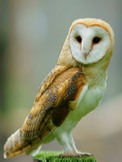
For various reasons, I moved house in 1993, and found myself living in a Wealden farmhouse with several acres of land just outside Scaynes Hill. The land consisted of 4 fields which were used for grazing sheep and horses, and just over 2 acres of mixed woodland. You can imagine my excitement when one day I saw a barn owl flying in the afternoon, and later on that year, when we got back from a holiday, we were told by our friends who had been looking after the house while we were away that they had seen a barn owl regularly. About 100 metres from the house is a large open steel-framed barn, and this looked ideal as a site for a barn owl box, and so I erected one high up on the wall in one corner. I also made two more boxes and fixed them to large trees on the edge of the woods. I can still remember how difficult it was to get the box in position. I had made it from plywood and by the time it was finished it was really quite heavy. I am one of these people who (stupidly) likes doing practical things on their own, rather than seeking help, and so I put the box up on my own. I first of all tied a rope to the box and looped it over an iron girder higher up than the position of the box, I then hauled it up, climbed up the ladder and slotted it into place. I had already worked out a way of fixing it to the wall by attaching a vertical piece of wood to the back of the box and then slotting this behind a horizontal girder that ran along the wall.
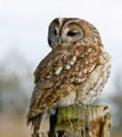
Tawny Owl
Barn Owl
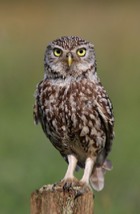
Little Owl
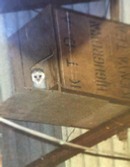
Young owl chick on platform outside entrance to box
After that, we seemed to have a pair in the box every year, and I think they produced offspring most years. In 2008 we had a small oak-framed cart-shed erected just next to our garden, which is about 150 metres from the big barn, and as soon as the roof was on, I erected another barn owl box in it. This time, it was one that I bought off the internet. There were no walls to the cart-shed, just the oak frame. Within about 3 weeks, there was a barn owl in the box! Later that summer, in August, two barn owl chicks were noted on the platform of the box in the big barn, and a few days later the chicks could be heard in the large oak trees at the edge of the garden. Following this, it became common to see the beautiful adult birds flying around in the late afternoon, and in March, 2009, three adults were seen flying together at dusk. Later that year, we had a visit from the West Sussex official barn owl observer, and he opened the box in the big barn and found one chick, which he ringed. He estimated it to be 39 days old, from measurements of its wing feathers, which meant that it was born on my birthday!
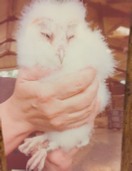
39 day old chick which has just been ringed
Because the cart-shed is just on the edge of the garden, in September 2012 we decided to put a camera in the box there, and we have had a functioning camera there ever since. At about the same time, we boarded up the sides of the barn, and left a triangular aperture at the apex of the gable end, through which the owls can come and go. The camera signal is transmitted across the lawn, and is fed into the TV in the kitchen. By selecting the external source, we can watch the owls in the box, and because the camera uses infra red light, we get a very good picture at all times. Sometimes the owls are just sleeping, and you can only just tell that they are alive by a very slight movement caused by their breathing, but watching them is quite addictive, and we often say that watching a sleeping owl is much more interesting than a lot of the programmes on the TV! As I am writing this article, they are grooming each other and are a picture of marital bliss.
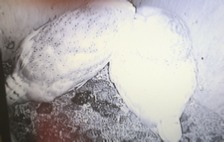
Pair of barn owls in nesting-box. Fresh pellets can be seen (black), and the floor of the box is about 4 inches deep in the bones of prey, mostly field voles
In August, 2010, we had another visit from the barn owl observer, and he found evidence, in the form of chewed owl pellets, of a further brood in the big barn. In the cart-shed there was a pair, with one cold egg, but unfortunately attempts to capture the birds and ring them failed. Both birds escaped around the edge of the net which was thrown over the opening, while the hatch at the side was opened. This was very frustrating, because we had noted that one of the birds was ringed, and it would have been very interesting to see when and where the ring had been applied.
We have waited a few years now, and are yet to see chicks hatching on camera, but are ever hopeful. Last year (2015), there was a pair in the box all winter, and although we saw them mating, no eggs were laid. Apparently, 2015 was a very bad year for field voles, which are the main diet of the barn owl, and if the adults are not getting enough to eat, then they do not lay eggs. We had a solitary owl in the box from October 2015, and then in February 2016 it was joined by another. We are therefore hoping that we will hear the patter of tiny feet later in the summer. It is now March, and the egg-laying does not usually start until the end of April so there is still some time to go. Both owls are remarkably tolerant of human presence in the vicinity, and we often see them perched at the triangular owl window, which is easily visible from the kitchen.
Observing barn owls so near to the house has given us an incredible amount of pleasure. They are stunningly beautiful birds: they are totally silent when they fly, and they move in the air with a mixture of gliding and occasional lazy wing beats, constantly turning in the air as they hunt for prey. To the untrained eye, they appear to be white, but in fact they are a cream colour overlaid with a mixture of honey and pale grey. The female appears slightly larger than the male, and she has darker speckles on her breast feathers. A few years ago the numbers were down, but it seems that in Sussex at least, the numbers are holding up well, and that is certainly borne out by our own experience.
We will update the website later in the year if we have news of any new arrivals.